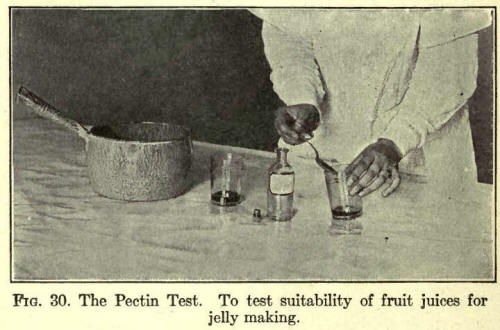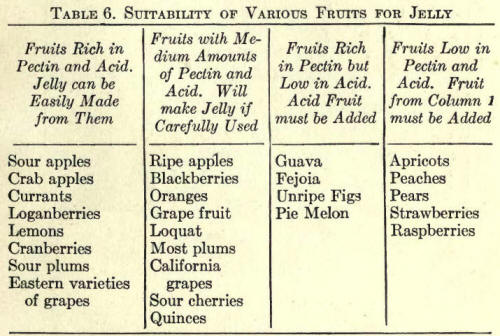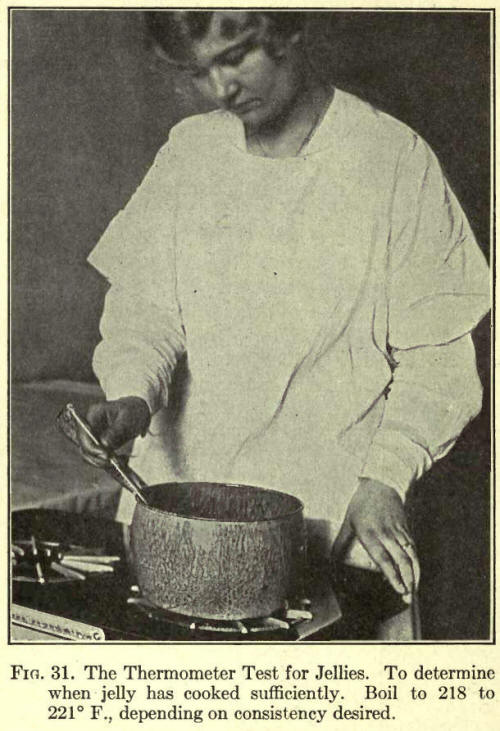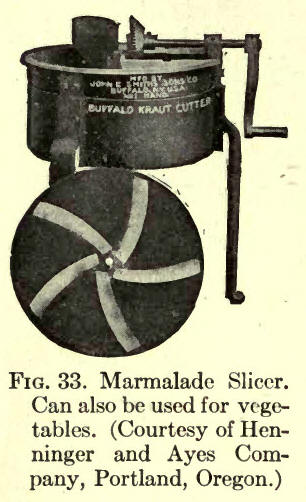|
The production of both
jellies and marmalades depends on the same principles, and the methods
of manufacture are similar. For these reasons they have been discussed
together in this chapter.
The following paragraphs
give the fundamental principles as well as a discussion of various tests
for jelly.

These enable anyone at
all familiar with cooking to obtain uniform results.
38. Fruits for Jelly.
A fruit jelly depends for its consistency upon three substances. These
are pectin and acid, from the fruit, and sugar, which is added. If any
one of the three components is lacking or too small in amount, jelly
cannot be made.
Certain fruits are rich
in both pectin and acid. Examples are sour apples, crab apples,
currants, loganberries, and lemons. Jelly is easily made from these
fruits. Some fruits contain moderate amounts of pectin and acid.
Examples are loquats, oranges, ripe apples, blackberries, grape fruit,
and some varieties of plums. Jellies can be made from these fruits if
care is taken. Some fruits are rich in pectin but low in acid. The
guava, quince, and fejoia are examples. Acid fruits must be added to
such fruits. Other fruits are low in pectin but rich in acid; for
example, rhubarb and gooseberries. Still other fruits are deficient in
both acid and pectin. Peaches, apricots, prunes, pears, strawberries,
and raspberries belong to this class. They must be combined with such
fruits rich in pectin as currants, crab apples, or sour apples, before
jelly can be made from them.

39. Preparing and Cooking the Fruit.
The fruits are prepared for cooking by cutting in pieces or by crushing.
Berries and currants should be crushed. Other fruits are cut.

The pectin is held in the tissues of the
fruit and in most cases must be liberated by boiling. Jellies can be
made from currants, loganberries, and cranberries by using the juice
obtained by crushing and pressing the fresh fruit without cooking, but
even these soft fruits give firmer jellies if boiled before extracting
the juice. In
cooking the fruit, water must be added to the less juicy varieties, such
as apples, plums, etc. Only enough should be added to barely cover the
fruit; if too much is added the juice will be too dilute and failure
will result. Currants, grapes, and berries need no added water.
The fruits should be cooked only until
tender. For apples this will be ten to fifteen minutes' boiling. Berries
should only be heated to boiling. Oranges, lemons, and grape fruit are
tough and require about an hour's boiling. Long boiling of any fruit
results in loss of flavor.
40. Expressing and Clearing the Juice.
The hot juice may be pressed from the fruit or may be allowed to simply
drain from the fruit through a cloth. The latter method is usually
employed in the household. In factories the juice is pressed from the
hot fruit with heavy pressure. If the juice is merely allowed to drain
from the fruit through a jelly bag it will be clearer than if obtained
by pressure, but pressing will give a larger yield of juice and the
juice will contain more pectin. Both methods may be combined by allowing
most of the juice to drain from the fruit through a jelly bag, followed
by pressing out the juice from the residual pulp in a small press or by
twisting the jelly bag to exert pressure. Juice obtained by pressure
must be filtered through a bag several times to clear it. If this is
done, very clear bright jelly can be made from it.
All fruit juices for jelly making should be
made as clear as possible by straining or filtering.
41. Testing for Pectin. If any doubt
as to the, jelling properties of the juice exists, it should be tested
for pectin. Failure can often be averted by this test.
Obtain a small amount (a ten cent bottle) of
grain alcohol from the druggist. To one teaspoonful of the juice in a
glass add one teaspoonful of the alcohol and stir slowly. If the juice
is rich in pectin, a very large amount of bulky gelatinous material will
form in the glass, almost turning the material to a soft jelly. Juices
moderately rich in pectin will give a few large pieces of gelatinous
material and juices too poor in pectin to make jelly will give a few
small flaky pieces of sediment.
If the juice proves poor in pectin it must
be blended with a juice rich in pectin. See paragraph 43 for the amount
of sugar to add to the juices of various pectin content. The less pectin
the fruit contains the less sugar can be used.
42. Testing for Acid. Fruits rich
enough in pectin to give a good jelly may not possess enough acid. No
accurate simple household method can be given, although the following
test will aid in judging of the acidity of the juice.
To one teaspoonful of lemon juice add nine
teaspoonfuls of water, and one-half teaspoonful of sugar. Mix in a
glass. Place in another glass a little of the fruit juice, but add no
water to it.
Compare the tartness of the two liquids by taste. If the fruit juice is
not as sour as the diluted lemon juice it is deficient in acid and it
will be necessary to raise the acidity of the fruit juice by adding
lemon or other sour juice.
With a little practice and experience this
test can be made very useful, although it is, of course, not very
accurate. 43.
Addition of Sugar. The amount of sugar to add to the juice will vary
with the pectin and acid content of the fruit. Juices such as
loganberry, currant, crab apple, and sour apples, that are rich in acid
and pectin, will make good jellies if one cup or as much as one and
one-quarter cups of sugar are used to each cup of juice. In some cases
as much as one and one-half cups of sugar can be used.
With fruit juices only moderately rich in
pectin, but still of fair jelling quality, three-fourths of a cup of
sugar may be used and with fruits low in pectin, only one-half a cup of
sugar may be used.
The reason for using less sugar with fruits poorer in pectin is seen
from the following discussion. To make jelly, the juice must finally
contain a high amount of sugar (55 to 65%), and enough pectin and acid
to form a jelly with the sugar. Boiling the juice after adding the sugar
concentrates the pectin by boiling off the excess water. The boiling
must continue until the jelly contains 55% or over of sugar. The more
sugar is added the less boiling is necessary and for the same reason the
less concentrating of the pectin in the juice takes place. If a small
amount of sugar is added, more boiling down is necessary to produce the
requisite high concentration of sugar and this results in greater
boiling down and concentrating of the pectin. Thus, if to a cupful of
juice poor in pectin only a half cupful of sugar is added the juice must
be boiled down to a relatively small volume and this will so increase
the pectin in proportion to the sugar that a jelly will usually result.
The sugar may be added cold as there is no
special virtue in warming it.
44. Sheeting Test for Jelling Point.
The juice and sugar should be boiled down rapidly in shallow pots. Long
boiling, such as is necessary in large amounts in deep pots, results in
loss of flavor, darkening of color, and caramelization of the sugar.
The juice must be boiled down until it will
jell when cold. This will be between 55 and 65% or more sugar, depending
upon the pectin content of the fruit. The usual way of testing this
point is to allow the jelly to drip from a large spoon. If it falls from
the spoon in wide sheets it is considered done. It is also usually done
when the boiling jelly forms large bubbles and apparently "tries to jump
out of the pot."
 45.
Thermometer Test. A more accurate test is the thermometer test. A
candy or other good thermometer is kept in the boiling liquid. As the
juice boils down the boiling temperature increases. When it reaches 221°
F. or 105° C., it has reached the proper point for a stiff jelly. The
thermometer must be kept well immersed in the boiling juice for this
test. (See Fig. 30.) 45.
Thermometer Test. A more accurate test is the thermometer test. A
candy or other good thermometer is kept in the boiling liquid. As the
juice boils down the boiling temperature increases. When it reaches 221°
F. or 105° C., it has reached the proper point for a stiff jelly. The
thermometer must be kept well immersed in the boiling juice for this
test. (See Fig. 30.)
When the boiling point reaches 221° F., it
merely indicates that the jelly contains 65% sugar. This will mean a
stiff jelly that will stand shipping, assuming that the fruit juice
contains sufficient pectin and acid. If a less firm jelly is desired, it
should be boiled only to 219 or 218° F. Often for household use such a
jelly is more desirable than a very stiff jelly. It must be remembered
than these figures apply only to fruits with a sufficient amount of
pectin and acid.
46. Hydrometer Test for Jelling Point. The various types of
hydrometers described under "Sirups for Canning" (see paragraph 11) may
be used to test the jelling point. Their use is not so convenient as
that of the thermometer. They are more certain and satisfactory than the
sheeting test.
While the jelly is boiling hot, pour it into a tall glass or tin or
copper cylinder: A tall narrow twenty-five cent flower vase, or a tall
narrow olive jar, or even a quart milk bottle will answer for a
cylinder. Insert the hydrometer and read the degree at the surface of
the liquid. When the test reads 32° Baume or 62° Brix or Balling in the
hot juice, a stiff jelly will result if the juice contains sufficient
pectin. Similarly, a "quivery" or less firm jelly will result at 29°
Baumc or 58° Balling or Brix, assuming that the fruit contains
sufficient pectin and acid.
47. Meaning of Thermometer and Hydrometer
Tests. These tests simply indicate that the jelly contains a certain
amount of sugwr and that boiling has concentrated the juice down to this
sugar content. It does not necessarily mean that one will always obtain
a jelly by boiling the juice down to the temperatures or Baume and
Balling degrees mentioned above. If the fruit is deficient in pectin and
acid or in only one of these constituents, jelly cannot be made,
regardless of the amount of boiling taking place.
On the other hand, if sufficient pectin and
acid are present, the above tests are very valuable in determining the
jelling point.
48. Pouring and Cooling the Jelly. Pour the jelly into glasses or
other containers. Paper jelly containers are now on the market which
answer the purpose very well. The glasses should be dry.
If the jelly is poured through a piece of
cheesecloth or tea strainer into the glasses, any coarse particles will
be removed. Allow the jelly to cool overnight before sealing with
paraffin. 49.
Coating with Paraffin. When the jelly has set, paraffin should be
added to seal it. If paraffin is added to the hot jelly the jelly
"sweats" or moistens the sides of the glass between the paraffin and the
glass. This causes the paraffin to become loose so that it no longer
protects the jelly. The hot jelly also decreases or contracts in volume
as it cools—the paraffin sets before contraction ceases and is apt to
not fit down closely on the jelly later.
If when the jelly is cold, the inside of the
glass above the jelly is wiped perfectly dry with a cloth or if the
jelly is allowed to stand until this part of the glass is absolutely
dry, the paraffin. will adhere perfectly when added.
Add the paraffin hot enough to sterilize the
top of the jelly. This will insure its keeping.
50. Sterilization of Jellies. If
jellies contain less than 65% sugar, i. e., the jelly tests less than
32° Baume or 62° Balling or Brix when hot, or boils at less than 221°
F., it may ferment or mold unless sterilized in sealed glasses or jars.
In the hot interior valleys of California housewives lose a great many
glasses of jelly by fermentation. Under such conditions the jelly should
be boiled down to the point noted above or should be placed in jars and
sterilized. This can be done by pouring the hot jelly into scalded jars
and sealing at once. The glasses are then immersed in water at the
simmering point for fifteen minutes to sterilize the rubbers and caps.
Such jelly will keep under all conditions of weather.
51. Jellies without Cooking. A few
fruits are so rich in pectin and acid that jellies can be made from them
without heating the fruit or the juice and sugar. Such fruits are
currants, loganberries, and cranberries.
Crush the fruit thoroughly and press out the
juice with vigorous pressure to force the pectin out of the pulp. Strain
as clearly as possible.
Two methods may then be used. By the first
method, add one and one-half cups of sugar to each cup of juice and mix
thoroughly until the sugar dissolves. Pour into glasses and place the
glasses in the sun for several days until the jelly becomes firm. The
sun evaporates the excess moisture. Bright sunlight is necessary. When
jelly has formed, seal with paraffin.
Jelly may also be made without sun
evaporation if two cups of sugar are added to each cup of juice.
52. Jelly. Stocks. The juice obtained
by draining or pressing the hot fruit after cooking may be sterilized in
bottles as directed for fruit juices (see paragraph 32) or poured
boiling hot into jars or cans and sealed without cooking. This juice or
"jelly stock" can be used by the usual method at any time by adding
sugar and boiling down to the jelling point. This economizes on jelly
glasses and results in fresher flavored jellies.
53. Crystallization of Jellies.
Crystals form in grape jelly from the separation of cream of tartar.
There is no certain way of preventing this. It can be greatly minimized,
however, if the juice is boiled down about one-half after pressing and
is then stored in bottles or jars for about six months before being made
into jelly.
Crystallization in other jellies is caused by the presence of excess
sugar. This may be caused by the sugar added in making the jelly or may
be caused by crystals of glucose, a sugar found in all fruits. It can be
prevented if the jelly is boiled down so that it contains not more than
70% sugar. The use of the thermometer and hydrometer tests will guard
against this common defect in jellies.
54. Marmalades. Marmalades differ
from jellies only in the fact that they have pieces of the fruit
suspended in the jelly. Fruits for marmalade must be rich in pectin and
acid.
 The
principles of marmalade making are the same as for jelly making. First,
a portion of the fruit is boiled, pressed, and strained to give a pectin
solution. Part of the fruit is cut in thin slices, cooked till tender,
and added to the juice obtained by boiling and pressing. Sugar in equal
volume is added and the mixture boiled down to the jelling point. The
principles of marmalade making are the same as for jelly making. First,
a portion of the fruit is boiled, pressed, and strained to give a pectin
solution. Part of the fruit is cut in thin slices, cooked till tender,
and added to the juice obtained by boiling and pressing. Sugar in equal
volume is added and the mixture boiled down to the jelling point.
Orange marmalade is the best known. Dundee
marmalade is the standard. It is made in Scotland from the bitter
Seville orange shipped from Spain in brine. It possesses the peculiar
aromatic and bitter flavor of this orange.
In the United States the usual commercial
varieties of oranges, such as the Naval, Valencia, Mediterranean Sweet,
Satsuma, etc., are used in combination with lemons. Lemons furnish the
acid and oranges the pectin.
Grape fruit is also used a great deal for
inarrnalade, both alone and in combination with lemons.
Fruits rich in pectin, such as apples,
currants, and loganberries may be used as source of the pectin solution
and shreds of apricots, peach, watermelon rind, pear, quince, etc., may
be added to produce the marmalade effect. |

